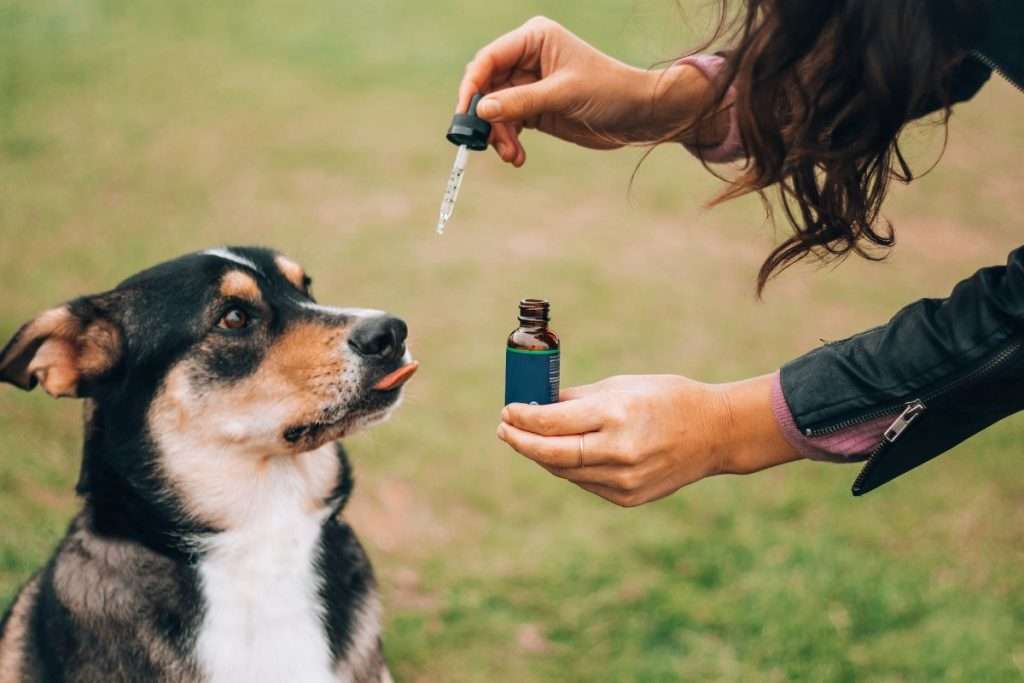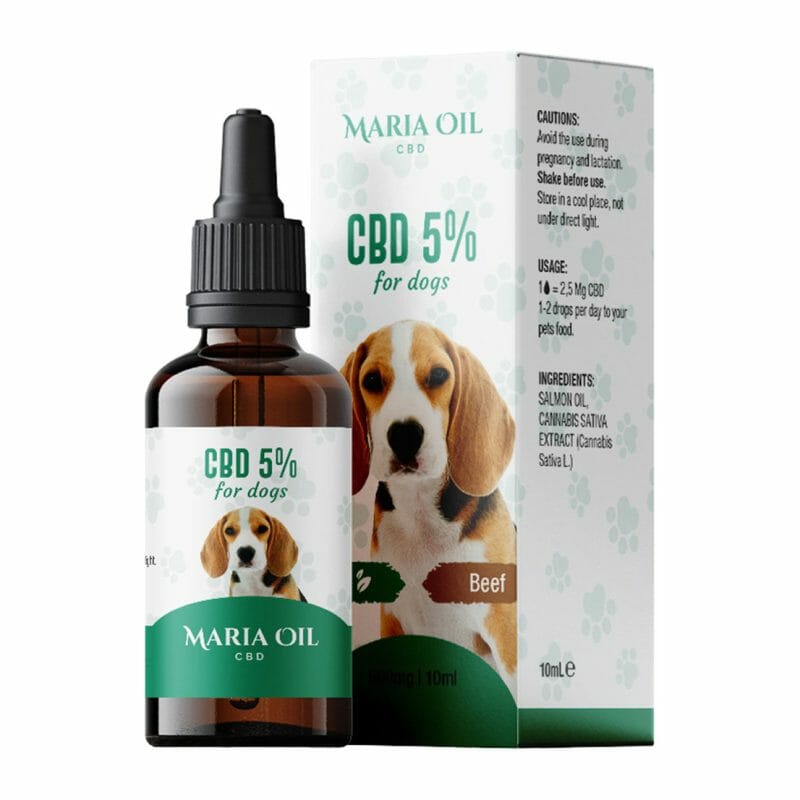Dogs, just like all of us, experience pain in certain circumstances. It is therefore important to recognise the cause and find a solution to help our four-legged friend.
The search for a painkiller for dogs must therefore start with the correct observation of your pet.
Is your dog really ill? Is he suffering from an illness or has he just had an operation? Are there visible symptoms? Is he behaving differently than usual?
Although it might be the most convenient solution, avoid administering painkillers found at home. The first advice is to rely on your vet to be able to identify the cause of your pet’s pain and give him a dog painkiller or, as we will see in this article, help him with natural products such as CBD.
In this way, you can avoid or limit side effects and treat your dog’s health while respecting his body. CBD is an increasingly popular resource not only for humans but also for pets. Find out everything you need to know about treating pain and using CBD products.
How to know if my god is sick
To first understand whether one’s dog is really sick, we can rely on certain behavioural signs, including:
- The dog licks itself constantly, even to the point of bleeding;
- The dog barks much more than normal;
- The dog becomes unsociable and tries to stay away from its owner;
- The dog becomes aggressive and does not allow itself to be approached.
Physical changes may also occur:
- Loss of weight or hair: If your dog loses weight or hair for no apparent reason, it could be a sign of malnutrition or illness;
- Eye or nasal discharge: if he has abnormally coloured eye or nasal discharge, an infection could be going on;
- Respiratory difficulties: if he is wheezing or having difficulty breathing, he may have a respiratory problem;
- Vomiting or diarrhoea: if he vomits or has diarrhoea, he could be suffering from a digestive problem or intoxication.
Your dog cannot tell you if he is sick, so it is important that you are alert to any changes in his behaviour or appearance.
When to use a painkiller for your dog
As we said, the use of a painkiller for dogs should always be discussed with your vet. Only your vet can assess your dog’s situation and prescribe the most suitable medication, as well as the dosage and duration of treatment.
In general, however, painkillers for dogs can be used in cases of:
- Acute pain: post-operative pain, trauma, injuries;
- Chronic pain: as, for example, in the case of arthritis, dysplasia, cancer;
- Pain associated with systemic diseases: kidney disease, heart disease.
It is also very important to remember not to abuse medication, which is why the first essential step is to be able to identify the exact cause of your dog’s discomfort. Once identified, the next step is to find out whether the painkiller can be effective in solving the problem.

Types of painkillers for gods
Before we look at which are the most popular dog painkillers, and their uses, let’s take a look at the types of drugs that can be used against pain for our dog:
- Opioids: are used for cases of respiratory depression, lack of appetite, vomiting, diarrhoea or as a relaxing/sedating action;
- Alpha-antagonists: these are used in cases of severe pain, which may be of varying degrees and nature. These include xylazine, medetomidine, detomidine and romifidine;
- NSAIDs: these are used to reduce post-operative inflammation and in cases of various types of trauma. Non-steroidal anti-inflammatory drugs can develop dangerous side effects for dogs, and therefore the supervision of a veterinarian is strongly recommended.
An extremely popular painkiller for dogs is Rimadyl, which can be used to treat inflammation and pain in acute and chronic pathological forms. This medicine is also useful for the treatment of post-operative pain.
Another painkiller for dogs is Previcox, one of the best known for relieving the pain and inflammation associated with osteoarthritis. It can also be used to treat post-operative pain and inflammation in soft tissue surgery and orthopaedic and dental surgery.
Maxxiflex, on the other hand, is a product that can improve a dog’s mobility and relieve joint pain. This drug is useful for helping dogs with pain caused by stiffness, lameness, canine arthritis, dysplasia and for recovery from orthopaedic surgery.
Alternative, but equally effective, methods include CBD oil for dogs, which is an excellent pain reliever. As with humans, in fact, the endocannabinoid system is also present in animals. CBD, a compound found in cannabis and hemp, interacts with receptors in the central and peripheral nervous system, which are involved in regulating mood, pain and other physiological functions.
CBD oils act as a natural painkiller and, consequently, have no major side effects for dogs. Several scientific journals have also shown that CBD oil can temporarily increase serotonin levels in dogs, thus acting as an anxiolytic. For this reason, it can also be useful in situations of travel or estrangement from the owner.

How to administer painkiller to your dog
Depending on the character of your pet and the intensity of the pain experienced, you can choose between different methods of administration.
Here is what you can do to administer the dog painkiller:
- Hide the tablet in the food: this is the easiest and safest method; choose a bite of meat, cheese or ham that your dog likes, and make sure that the tablet is completely wrapped up in the food so that he cannot see or hear it;
- Using a syringe without a needle: if your dog is reluctant to take the tablet hidden in the food, you can insert the syringe into his mouth (from the side) and gently press the plunger to release the medication, making sure he does not spit it out;
- Use a ‘pill gun’: this is a device that facilitates the administration of medication to dogs, you have to insert the tablet into the ‘pill gun’ and then place the device in your dog’s mouth, then gently press the button to release the tablet;
- Having the painkiller administered by a vet: if you are not sure how to administer the painkiller to your dog, you can take him to the vet and have a professional administer it.
Here are some tips for administering painkiller to your dog effectively:
- Be calm and patient;
- Do not force your dog to take the tablet;
- If your dog has difficulty swallowing the tablet, you can try crushing it in some water;
- Reward him after taking the tablet.
- During this operation it is essential that you remain calm in order to cause as little stress as possible to your dog, who is already in pain.
During this operation it is essential that you remain calm in order to cause as little stress as possible to your dog, who is already in pain.
Can I give a human painkiller to my dog?
The first piece of advice is to never give a human drug to your pet: dog painkillers, in fact, have completely different properties. To give an example, ibuprofen (contained within drugs such as Moment) is highly toxic to dogs. More specifically, NSAIDs (non-steroidal anti-inflammatory drugs) should be avoided completely without veterinary supervision. These, in fact, can lead to dysfunction, intestinal problems and intoxication in dogs. Beware also of tachypirin, which contains paracetamol, and aspirin.
It is important, therefore, not to panic and resort to medicines that we commonly use for ourselves, mainly NSAIDs, as they could be dangerous for our four-legged friend. Going to your vet and getting a prescription for a dog painkiller, even in this case, remains the best choice.
-
Product on sale
 CBD Oil 5% for DogsOriginal price was: %s.£13.99Current price is: %s.
CBD Oil 5% for DogsOriginal price was: %s.£13.99Current price is: %s.
Painkillers for dogs without prescription
It is extremely risky to administer non-prescription medication to your dog. However, there are painkillers for dogs that are specially designed to be safe and effective even without veterinary supervision.
Here are some (mostly natural) remedies that you can rely on:
- FermaDol Forte. This is a painkiller for dogs manufactured by Liquid Wellness, Italy, and is suitable for relieving any joint pain the dog may have;
- Confis Ultra 240. This is also a painkiller for dogs produced in Italy, more specifically in Turin, by Candioli Pharma. It is particularly indicated for cases of osteoarthritis, a condition that affects around 20% of dogs;
- Artikrill. This is a painkiller again indicated for dogs suffering from osteoarthritis. It contains EPA and DHA fatty acids from fish oil, vitamin E and other nutrients:
- Hip & Joint Mobility+. This dog painkiller is useful in relieving pain in cases of hip dysplasia and other joint-related conditions. To restore proper joint mobility, this medicine contains active ingredients such as devil’s claw, MSM, chondroitin and turmeric;
- Jointsure. This, too, is a multifunctional supplement useful for restoring your dog’s energy and mobility. It is particularly suitable for elderly and adult dogs due to its active ingredients that soothe pain and support normal joint function.
These are some of the best-known painkillers for dogs that can be purchased without a prescription.
Are there any contraindications?
Painkillers can cause side effects in dogs, just as they do with medicines for humans. The most common side effects are:
- Vomiting;
- Diarrhoea;
- Faeces with blood;
- Inappetence;
- Increased water consumption;
- Skin rashes.
Should your dog show any of these signs, it is strongly recommended that you contact your vet as soon as possible to request a specific examination. As discussed in the section on the administration of human painkillers to dogs, NSAIDs can be extremely dangerous if not supervised by a vet.
Natural painkillers for my dog
The first question one asks oneself when one’s four-legged friend seems to be showing worrying signs is: ‘how can I help my dog who is in pain?’ One of the safest, and often also effective, methods is to rely on natural remedies. These include some simple measures that can help your dog gradually recover:
- Rest. Just as with humans, the starting point is rest. If a dog has joint or muscle problems, as is often the case over the years, you must encourage your pet not to exert himself (e.g. running in the garden or around the house) and to keep as quiet as possible;
- Rest in a comfortable place. In addition to preventing your dog from making sudden movements, it is equally important that your four-legged friend should have a comfortable, warm and clean place in which to rest. If the dog suffers from joint problems, it is also advisable to avoid any obstacles (such as stairs) on the way to its kennel;
- Soft, quality diet. A well-balanced diet helps to restore the functioning of the digestive system and consequently relieves pain. If the dog has pain in any part of the mouth, it is preferable to give soft, gentle food;
- Stay warm. On the advice of your veterinary surgeon, you can apply a warm compress to the part that is causing your dog pain;
In addition to these natural remedies, CBD products that help the body in general and have beneficial effects in supporting your pet’s recovery are very effective, as we will elaborate in more detail in the next section.
-
Product on sale
 CBD Oil 5% for DogsOriginal price was: %s.£13.99Current price is: %s.
CBD Oil 5% for DogsOriginal price was: %s.£13.99Current price is: %s.
How to dose natural painkillers correctly?
The correct dosage of natural painkillers for dogs depends on different factors such as the dog weight, the severity of pain and the specific type of remedy used. For this reason, it is crucial to consult a veterinarian before starting any treatment to make sure that the dosage is safe and effective for your dog’s needs.
Most dosage instructions are based on the weight of the dog. Knowing the dog’s weight is very important especially with regard to CBD dosage for dogs, as we are talking about a powerful and comprehensive remedy in itself.
Dosage may also vary depending on the type of natural remedy used. For example, supplements such as glucosamine and chondroitin may have different doses than herbs such as turmeric or omega-3 fish oil.
Finally, natural painkillers may be available in the form of capsules, tablets, liquids or special foods. Make sure you administer the remedy in the appropriate form according to your vet’s instructions.
How can I tell if the painkillers are working?
Let’s say you have found a non-prescription dog painkiller that seems suitable for the specific case you need to treat. How can you tell if the treatment works?
Let’s start with the assumption that many natural substances, such as omega-3 and or turmeric, need prolonged use over time to give meaningful answers.
That said, to understand whether dog painkillers are working, you need to carefully observe your pet’s behaviour and physical condition. Here are some signs that might indicate that painkillers are having a positive impact:
- Improved mobility: if your dog had difficulty moving or showed signs of lameness due to pain, an improvement in his mobility is a success;
- Increased activity: if your dog is more willing to play, walk or participate in activities that he avoided due to pain;
- Changes in behaviour: a reduction in signs of discomfort, such as anxiety, agitation or irritability;
- Appetite and hydration: an increase in food and water intake may indicate that the dog is better overall;
- Improvement in sleep quality: if pain is affecting your dog’s sleep, you may notice an improvement in sleep quality;
- Reduced pain expression: notice if you see fewer signs of discomfort, such as excessive licking of a body part or groaning;
- Reduced anxiety: some dogs may develop anxiety due to chronic pain.
Assessing the efficacy of painkillers should also be discussed with your vet, who can adjust the treatment according to your dog’s responses. Consult him regularly to assess the need for adjustments in your pet’s pain management plan.
The benefits of CBD for dogs
In addition to traditional methods, CBD can be used to relieve your dog’s pain. Cannabidiol has become increasingly popular over time in various medical therapies, precisely because of its multiple functionalities. CBD oil is therefore used for various reasons, which correspond to the known beneficial properties of legal marijuana.
According to Dr. Klein, chief veterinarian at the American Kennel Club (AKC), CBD can be used in dogs for:
- Anti-inflammatory properties;
- The cardiac benefits;
- The anti-nausea effect;
- The stimulation of appetite;
- The anxiolytic effect.
The AKC also conducted a scientific study in 2017 to evaluate the use of CBD in epileptic dogs that do not respond positively to traditional treatments. Cannabidiol can in fact help control tremors, tics and spasms.
CBD oil for dogs is administered orally, and it is therefore necessary to use a dropper to avoid overdoing it. Although the contraindications are mild, it is still preferable to maintain a dosage of around 0.45mg/kg per day. Over time, it is possible to increase the frequency of administration and go up to 5.00mg/kg per day.
Should the amount of CBD oil be exaggerated, the dog may experience episodes of lack of appetite, dehydration and fatigue. Even in this case, it is always a good idea to consult your vet first.
Legal CBD products for pets
CBD is a viable and effective option, a natural painkiller that will help relieve pain and improve your dog’s general condition. It is important to choose appropriate products from reputable companies, so you can be sure that you are buying a quality and truly effective product.
Always start with the minimum recommended dose, see how your four-legged friend reacts, allow time for his body to get used to it and for the product to run its course. Remember that this is a natural substance, so it has a different timeframe for taking effect than pain-relieving medicines. In addition, if you want to be really thorough, you can note the effects day by day, so you will also notice improvements and know how to manage the administration and dosage specifically for your dog. In fact, remember that every organism reacts differently and needs to be treated differently. If you have any doubts before, during or after dosing, please contact your vet, who will be able to help you manage the whole situation.
To find certified, legal and quality products, visit our online shop now where you can find and evaluate all CBD products for pets.
 Contact us
Contact us 






